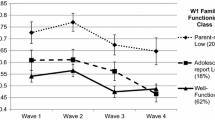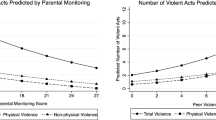Abstract
Although exposure to community violence and parental involvement have been previously found to independently predict aggressive behaviors, the interaction effect is less clear. Additionally, unique associations between exposure to community violence and reactive and proactive aggression, two widely-studied forms of aggression, in the context of parental involvement has yet to be examined. One population that may be of particular interest for such an investigation is immigrant adolescents, a population at increased risk of experiencing community violence and develo** aggression. The current study therefore examined the joint and interactive contribution of community violence and parental involvement in the explanation of reactive and proactive forms of aggression among 81 immigrant adolescents (M age = 15.44). As expected, exposure to community violence was positively associated with both reactive and proactive aggression. Parental involvement, however, was not associated with either form of aggression. Further, the association between exposure to community violence and proactive aggression was found to vary by level of parental involvement. Contrary to expectations, when levels of parental involvement were high, there was a positive association between exposure to community violence and proactive aggression and no association when levels of parental involvement were low. Results have important implications for understanding unique developmental pathways and distinct correlates of reactive and proactive aggression among immigrant adolescents.

Similar content being viewed by others
References
Aiken, L. S., & West, S. G. (1991). Multiple regression: Testing and interpreting interactions (pp. 75–87). Newbury Park: Sage Publications
Arbona, C., & Power, T. G. (2003). Parental attachment, self-esteem, and antisocial behaviors among African American, European American, and Mexican American adolescents. Journal of Counseling Psychology, 50(1), 40. doi:10.1037/0022-0167.50.1.40.
Arnett, J. J. (1992). Reckless behavior in adolescence: A developmental perspective. Developmental Review, 12(4), 339–373. doi:10.1016/0273-2297(92)90013-R.
Bandura, A. (1978). Social learning theory of aggression. Journal of Communication, 28(3), 12–29. doi:10.1111/j.1460-2466.1978.tb01621.x.
Barber, B. K., & Harmon, E. L. (2002). Violating the self: Parental psychological control of children and adolescents. Washington, DC: American Psychological Association.
Birman, D. & Chan, W. (2008, May). Screening and assessing immigrant and refugee youth in school based mental health programs. Issue brief #1, Center for Health and Health Care in Schools, George Washington University. http://www.rwjf.org/files/research/3320.32211.0508issuebriefno.1.pdf.
Bronfenbrenner, U. (1979). The ecology of human development: Experiments by nature and design. Cambridge: Harvard University Press.
Burt, S., Donnellan, M., Iacono, W., & McGue, M. (2011). Age-of-onset or behavioral sub-types? A prospective comparison of two approaches to characterizing the heterogeneity within antisocial behavior. Journal of Abnormal Child Psychology, 39(5), 633–644.
Burt, S., Donnellan, M. M., & Tackett, J. (2012). Should social aggression be considered ‘Antisocial’? Journal of Psychopathology & Behavioral Assessment, 34(2), 153. doi:10.1007/s10862-011-9267-0.
Burt, S., & Hopwood, C. (2010). A comparison of two different approaches to characterizing the heterogeneity within antisocial behavior: Age-of-onset versus behavioral sub-types. Journal of Personality Disorders, 24(2), 272–283. doi:10.1521/pedi.2010.24.2.272.
Bushman, B. J., & Anderson, C. A. (2001). Is it time to pull the plug on the hostile versus instrumental aggression dichotomy? Psychological Review, 108, 273–279.
Card, N. A., & Little, T. D. (2006). Proactive and reactive aggression in childhood and adolescence: A meta-analysis of differential relations with psychosocial adjustment. International Journal of Behavioral Development, 30(5), 466–480. doi:10.1177/0165025406071904.
Centers for Disease Control and Prevention. (2013). Youth risk behavior survey. www.cdc.gov/yrbs.
Child Trends. (2014). Immigrant children. Available at http://www.childtrends.org/?indicators=immigrant-children. See more at http://www.childtrends.org/?indicators=immigrant-children#sthash.HtZ7L9hr.dpuf.
Davidson, T. M., & Cardemil, E. V. (2009). Parent-child communication and parental involvement in Latino adolescents. The Journal of Early Adolescence, 29(1), 99–121. doi:10.1177/0272431608324480.
Dinh, K. T., Roosa, M. W., Tein, J. Y., & Lopez, V. A. (2002). The relationship between acculturation and problem behavior proneness in a Hispanic youth sample: A longitudinal mediation model. Journal of Abnormal Child Psychology, 30(3), 295–309.
Dishion, T. J., & Patterson, G. R. (2006). The development and ecology of antisocial behavior. In D. Cicchetti & D. J. Cohen (Eds.), Developmental psychopathology: Vol. 3. Risk, disorder, and adaptation (2nd Ed., pp. 503–541). Hoboken, NJ: Wiley.
Dodge, K. A. (1991). The structure and function of reactive and proactive aggression. In D. J. Pepler & K. H. Rubin (Eds.), The development and treatment of childhood aggression (pp. 201–218). Hillsdale, NJ: Lawrence Erlbaum Associates Inc.
Dryfoos, J. G. (1998). Safe passage: Making it through adolescence in a risky society. New York: Oxford University Press.
Eagly, A. H., & Steffen, V. J. (1986). Gender and aggressive behavior: A meta-analytic review of the social psychological literature. Psychological Bulletin, 100(3), 309–330. doi:10.1037/0033-2909.100.3.309.
Faul, F., Erdfelder, E., Buchner, A., & Lang, A.-G. (2009). Statistical power analyses using G*Power 3.1: Tests for correlation and regression analyses. Behavior Research Methods, 41, 1149–1160.
Finzi-Dottan, R., Bilu, R., & Golubchik, P. (2011). Aggression and conduct disorder in former Soviet Union immigrant adolescents: The role of parenting style and ego identity. Children and Youth Services Review, 33(6), 918–926.
Fowler, P. J., Tompsett, C. J., Braciszewski, J. M., Jacques-Tiura, A. J., & Baltes, B. B. (2009). Community violence: A meta-analysis on the effect of exposure and mental health outcomes of children and adolescents. Development and Psychopathology, 21(1), 227–259. doi:10.1017/S0954579409000145.
Frick, P. J. (1991). The Alabama parenting questionnaire. Unpublished rating scale, University of Alabama.
Gorman-Smith, D., Henry, D. B., & Tolan, P. H. (2004). Exposure to community violence and violence perpetration: The protective effects of family functioning. Journal of Clinical Child & Adolescent Psychology, 33(3), 439–449. doi:10.1207/s15374424jccp3303_2.
Guerra, N. G., Tolan, P. H., & Hammond, W. R. (1994). Prevention and treatment of adolescent violence. In D. Leonard, J. H. Gentry, & P. Schlegel (Eds.), Reason to hope: A psychosocial perspective on violence & youth (pp. 383–403). Washington, DC: American Psychological Association, xviii, doi: 10.1037/10164-015
Hawkins, J. D., Herrenkohl, T. F., Farrington, D. P., Brewer, D. C. R. F., & Harachi, T. W. (1998). A review of predictors of youth violence (pp. 106–146). Serious and violent juvenile offenders: Risk factors and successful interventions.
Hubbard, J. A., McAuliffe, M. D., Morrow, M. T., & Romano, L. J. (2010). Reactive and proactive aggression in childhood and adolescence: Precursors, outcomes, processes, experiences, and measurement. Journal of Personality, 78(1), 95–118. doi:10.1111/j.1467-6494.2009.00610.x.
Huesmann, L. R. (1998). The role of social information processing and cognitive schema in the acquisition and maintenance of habitual aggressive behavior. In R. G. Geen & E. Donnerstein (Eds.), Human aggression: Theories, research, and implications for social policy (pp. 73–109). San Diego, CA: Academic Press.
Joshi, P. T., & Kaschak, D. G. (1998). Exposure to violence and trauma: Questionnaire for adolescents. International Review of Psychiatry, 10, 208–215. doi:10.1080/09540269874790.
Juang, L. P., Syed, M., Cookston, J. T., Wang, Y., & Kim, S. (2012). Acculturation-based and everyday family conflict in Chinese American families. New Directions for Child and Adolescent Development, 2012(135), 13–34. doi:10.1002/cd.20002.
Lambert, S. F., Boyd, R. C., Cammack, N. L., & Ialongo, N. S. (2012). Relationship proximity to victims of witnessed community violence: Associations with adolescent internalizing and externalizing behaviors. American Journal of Orthopsychiatry, 82(1), 1–9.
Latzman, R. D., Vaidya, J. G., Watson, D., & Clark, L. A. (2011). Components of disinhibition (vs. constraint) differentially predict aggression and alcohol use. European Journal of Personality, 25, 477–486. doi:10.1002/per.821.
Laub, J. H., & Sampson, R. J. (1994). Unemployment, marital discord, and deviant behavior: The long-term correlates of childhood misbehavior. In T. Hirschi & M. R. Gottfredson (Eds.), The generality of deviance (pp. 235–252). Piscataway, NJ US: Transaction Publishers.
Liu, J. J., Lewis, G. G., & Evans, L. L. (2013). Understanding aggressive behaviour across the lifespan. Journal of Psychiatric and Mental Health Nursing, 20(2), 156–168. doi:10.1111/j.1365-2850.2012.01902.x.
Loeber, R., & Stouthamer-Loeber, M. (1986). Family factors as correlates and predictors of juvenile conduct problems and delinquency. Crime & Justice, 7, 29.
Marshall, L. A., & Cooke, D. J. (1999). The childhood experiences of psychopaths: A retrospective study of familial and societal factors. Journal of Personality Disorders, 13, 211–225.
Masten, A. S. (1994). Resilience in individual development: Successful adaptation despite risk and adversity. In M. C. Wang & E. W. Gordon (Eds.), Educational resilience in inner-city America: Challenges and prospects (pp. 3–25). Hillsdale, NJ: Lawrence Erlbaum Associates Inc.
Miller, N. E., Mowrer, O. H., Doob, L.W., Dollard, J., & Sears, R. R. (1958). Frustration-aggression hypothesis. In C. L. Stacey (Ed.), Understanding human motivation (pp. 251–255). Cleveland, OH: Howard Allen Publishers. doi:10.1037/11305-023
Mrug, S., & Windle, M. (2010). Prospective effects of violence exposure across multiple contexts on early adolescents internalizing and externalizing problems. Journal of Child Psychology and Psychiatry, 51(8), 953–961. doi:10.1111/j.1469-7610.2010.02222.x.
O’Donnell, D. A., Schwab-Stone, M. E., & Muyeed, A. Z. (2002). Multidimensional resilience in urban children exposed to community violence. Child Development, 73(4), 1265–1282. doi:10.1111/1467-8624.00471.
Pearce, M. J., Jones, S. M., Schwab-Stone, M. E., & Ruchkin, V. (2003). The protective effects of religiousness and parent involvement on the development of conduct problems among youth exposed to violence. Child Development, 74(6), 1682–1696. doi:10.1046/j.1467-8624.2003.00631.x.
Poulin, F., & Boivin, M. (2000). Reactive and proactive aggression: Evidence of a two-factor model. Psychological Assessment, 12, 115–122.
Raine, A., Dodge, K., Loeber, R., Gatzke-Kopp, L., Lynam, D., Reynolds, C., & Liu, J. (2006). The reactive-proactive aggression questionnaire: Differential correlates of reactive and proactive aggression in adolescent boys. Aggressive Behavior, 32(2), 159–171. doi:10.1002/ab.20115.
Richters, J. E., & Martinez, P. (1992). Things I have seen and heard: An interview for young children about exposure to violence. Rockville, MD: Child and Adolescent Disorders Research Branch, National Institute of Mental Health.
Richters, J. E., & Martinez, P. (1993). The NIMH community violence project: I. Children as victims of and witnesses to violence. Psychiatry, 56, 7–21.
Schaeffer, C. M., Petras, H., Ialongo, N., Poduska, J., & Kellam, S. (2003). Modeling growth in boys’ aggressive behavior across elementary school: Links to later criminal involvement, conduct disorder, and antisocial personality disorder. Developmental Psychology, 39(6), 1020–1035. doi:10.1037/0012-1649.39.6.1020.
Schofield, T. J., Parke, R. D., Kim, Y., & Coltrane, S. (2008). Bridging the acculturation gap: Parent–child relationship quality as a moderator in Mexican American families. Developmental Psychology, 44(4), 1190.
Schwartz, D., & Proctor, L. J. (2000). Community violence exposure and children’s social adjustment in the school peer group: The mediating roles of emotion regulation and social cognition. Journal of Consulting and Clinical Psychology, 68(4), 670–683. doi:10.1037/0022-006X.68.4.670.
Smith, C., & Krohn, M. D. (1995). Delinquency and family life among male adolescents: The role of ethnicity. Journal of Youth and Adolescence, 24, 69–93.
Stanton-Salazar, R. D., & Spina, S. U. (2003). Informal mentors and role models in the lives of urban Mexican-origin adolescents. Anthropology & Education Quarterly, 34, 231–254. doi:10.1525/aeq.2003.34.3.231.
Stevens, G. M., Vollebergh, W. M., Pels, T. M., & Crijnen, A. M. (2005). Predicting externalizing problems in Moroccan immigrant adolescents in the Netherlands. Social Psychiatry and Psychiatric Epidemiology, 40(7), 571–579. doi:10.1007/s00127-005-0926-x.
Stevens, G. M., Vollebergh, W. M., Pels, T. M., & Crijnen, A. M. (2007). Parenting and internalizing and externalizing problems in Moroccan immigrant youth in the Netherlands. Journal of Youth and Adolescence, 36(5), 685–695. doi:10.1007/s10964-006-9112-z.
Tackett, J. L., Waldman, I. D., & Lahey, B. B. (2009). Etiology and measurement of relational aggression: A multi-informant behavior genetic investigation. Journal of Abnormal Psychology, 118(4), 722–733. doi:10.1037/a0016949.
United States Department of Homeland Security. (2013). Yearbook of immigration statistics: 2013. Washington, DC: U.S. Department of Homeland Security, Office of Immigration Statistics.
Wenk, D., Hardesty, C. L., Morgan, C. S., & Blair, S. (1994). The influence of parental involvement on the well-being of sons and daughters. Journal of Marriage and the Family, 56(1), 228–234. doi:10.2307/352718.
Youngstrom, E., Weist, M. D., & Albus, K. E. (2003). Exploring violence exposure, stress, protective factors and behavioral problems among inner-city youth. American Journal of Community Psychology, 32(1–2), 115–129. doi:10.1023/A:1025607226122.
Zlomke, K. R., Lamport, D., Bauman, S., Garland, B., & Talbot, B. (2013). Parenting adolescents: Examining the factor structure of the Alabama parenting questionnaire for adolescents. Journal of Child and Family Studies,. doi:10.1007/s10826-013-9803-5.
Author information
Authors and Affiliations
Corresponding author
Rights and permissions
About this article
Cite this article
Hamner, T., Latzman, R.D. & Chan, W.Y. Exposure to Community Violence, Parental Involvement, and Aggression Among Immigrant Adolescents. J Child Fam Stud 24, 3247–3257 (2015). https://doi.org/10.1007/s10826-015-0128-4
Published:
Issue Date:
DOI: https://doi.org/10.1007/s10826-015-0128-4




